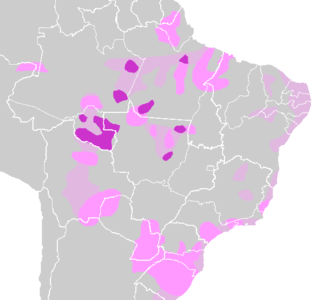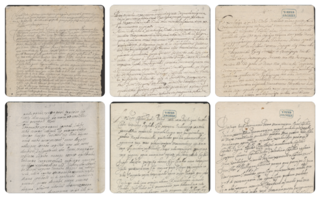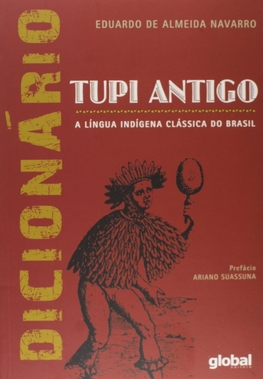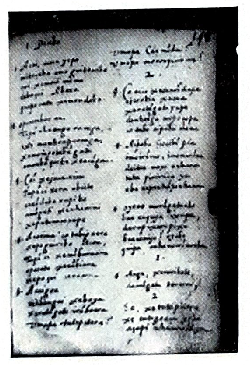
The Tupi or Tupian language family comprises some 70 languages spoken in South America, of which the best known are Tupi proper and Guarani.
Old Tupi, Ancient Tupi or Classical Tupi is a classical Tupian language which was spoken by the indigenous Tupi people of Brazil, mostly those who inhabited coastal regions in South and Southeast Brazil. In the words of Brazilian tupinologist Eduardo Navarro, "it is the classical indigenous language of Brazil, and the one which had the utmost importance to the cultural and spiritual formation of the country".
The term General Language refers to lingua francas that emerged in South America during the 16th and 17th centuries, the two most prominent being the Paulista General Language, which was spoken in the region of Paulistania but is now extinct, and the Amazonian General Language, whose modern descendant is Nheengatu.

The Tupinambá are one of the various Tupi ethnic groups that inhabit present-day Brazil, and who had been living there long before the conquest of the region by Portuguese colonial settlers. The name Tupinambá was also applied to other Tupi-speaking groups, such as the Tupiniquim, Potiguara, Tupinambá, Temiminó, Caeté, Tabajara, Tamoio, and Tupinaé, among others. Before and during their first contact with the Portuguese, the Tupinambás had been living along the entire Eastern Atlantic coast of Brazil.

The Nheengatu or Nenhengatu language, or Nenhengatu, also known as Modern Tupi and Amazonic Tupi, is a Tupi–Guarani language.
The Tupí or Tupinambá languages are a subgroup of the Tupi–Guarani language family.

Aryon Dall'Igna Rodrigues was a Brazilian linguist, considered one of the most renowned researchers of the indigenous languages of Brazil.

Jaguaripe is a municipality in the state of Bahia in the North-East region of Brazil. It covers 863.424 km2 (333.370 sq mi), and has a population of 18,981 with a population density of 18.32 inhabitants per square kilometer. Jaguaripe is located 130 km (81 mi) from the state capital of Bahia, Salvador. Jaguaripe shares a border with the municipalities of Aratuípe, Nazaré, Maragogipe, Laje, São Miguel das Matas, and Santo Antônio de Jesus. It was the first municipality created outside of Salvador, dating to 1693.
The Paulista General Language, also called Southern General Language and Austral Tupi, was a lingua franca and creole language formed in the 16th century, in the Captaincy of São Vicente. Today it is only of historical interest, as it has been a dead language since the beginning of the 20th century. It constituted the southern branch of the Língua Geral.
Tapirapé is a Tupí-Guaraní language of Brazil spoken near the Araguaia River, in the border of the states of Mato Grosso and Tocantins. As of 2020, the language has around 917 speakers, who belong to the Tapirapé ethnic group.

Chief Tibiriçá baptized as Martim Afonso was an Amerindian leader who converted to Christianity under the auspices of José de Anchieta. He led the Tupiniquim people of Piratininga and other tribes. His daughter, Bartira, took the name Isabel and married a Portuguese man named João Ramalho. After his conversion to Christianity he became a strategic ally and protector of the Jesuits and the Portuguese; his name appears on letters to Saint Ignatius of Loyola and King João III of Portugal. Tibiriçá chose to side with the Jesuits and against his own brother Piquerobi with help of his nephew and his son-in-law João Ramalho. His granddaughters and their descendants married Portuguese noblemen that led the colonization of São Paulo under Martim Afonso de Sousa, including Jorge Ferreira, Domingos Luiz, and Tristão de Oliveira, son of capitão-mor Antonio de Oliveira and Genebra Leitão de Vasconcelos, both of important noble families.
Proto-Tupian (PT) is the reconstructed common ancestor of all the Tupian languages. It consists, therefore, of a hypothetical language, reconstructed by the comparative method from data of the descendant languages.

Eduardo de Almeida Navarro is a Brazilian philologist and lexicographer, specialist in Old Tupi and Nheengatu. He is a full professor at the University of São Paulo, where he has been teaching Old Tupi since 1993, and Nheengatu since 2009. Eduardo Navarro is also the author of the books Método moderno de tupi antigo, 1998, and Dicionário de tupi antigo, 2013, important works on the Tupi language.

Camarão Indians' letters, also known as Tupi letters from Camarão Indians, are a series of six letters exchanged between Potiguara Indians during 1645, in the first half of the 17th century, in the context of the Dutch invasions of Brazil. They are the only known texts written by Brazilian Indians until the Independence of Brazil. The Camarão Indians' letters are also the only record of Old Tupi writing in Colonial Brazil. Today, the correspondence is stored in the archives of the Royal Library of the Netherlands, and has been preserved there for almost 400 years.

The Dicionário de tupi antigo: a língua indígena clássica do Brasil was compiled by the Brazilian lexicographer and philologist Eduardo de Almeida Navarro and published in 2013. The work was conceived with the goal of spreading knowledge of the Tupi language to a broader public.

Le langaige du Bresil is a vocabulary produced in the 1540s, considered the oldest substantial record of a Brazilian language, specifically of Old Tupi. It is contained in a manuscript located in the Bibliothèque nationale de France, cataloged as "Ms. Fr. 24269", from folio 53r to 54r, and presents 88 entries. Little is known about its compiler, a sea captain or voyage organizer, probably from Bordeaux or Rouen, named Jehan Lamy.

Art of Grammar of the Most Used Language on the Coast of Brazil is a book written in 1555 by Jesuit priest Joseph of Anchieta and first published in Portugal in the year 1595.

In the Village of Guaraparim is the title given to the longest play by Joseph of Anchieta, canonized in 2014, written exclusively in the Tupi language, a now dead language.

Christian Doctrine in the Brasílica Language is an undated, anonymous manuscript written almost entirely in Old Tupi.

This article deals with the etymology of the name of the city of Curitiba, capital of the Brazilian state of Paraná.
















